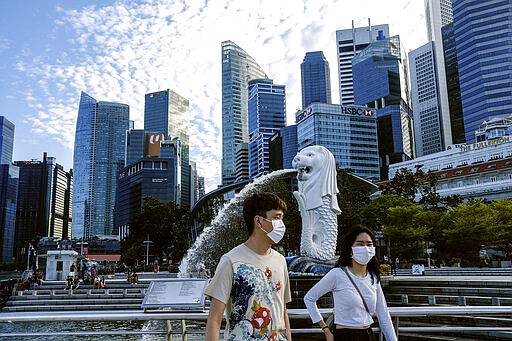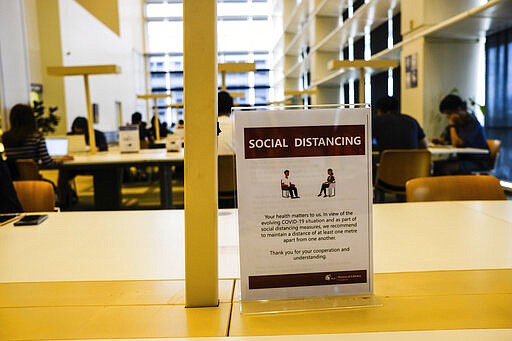Best strategies against virus: Track, isolate, communicate
EE Ming Toh | Hagadone News Network | UPDATED 5 years, 9 months AGO
SINGAPORE (AP) — Singapore, a tiny city-state of less than 6 million people, had one of the earliest and biggest clusters of cases of the coronavirus in early February, before it began its rapid, inexorable expansion around the globe.
Within weeks, the country's tally of infections with the highly contagious virus that causes COVID-19 was overtaken by skyrocketing caseloads in South Korea, several European countries and the U.S.
Some strategies are proving more effective than others in containing the pandemic: pro-active efforts to track down and isolate the infected, access to basic, affordable public health care, and clear, reassuring messaging from leaders. East Asia's experience with the 2003 outbreak of Severe Acute Respiratory Syndrome, which also originated in China, has likewise helped.
Since testing rates vary widely, it's hard to know for sure. But with the global number of infections surpassing 210,000, Singapore appears to be among the handful of places that tick all those boxes, though recent spikes in new cases show that any lapses can have dire consequences.
Singapore's first case, confirmed on Jan. 23, was a 66-year-old man from Wuhan, the Chinese city where the disease was first detected in December.
By mid-February, the number of recovered patients in the Southeast Asian city-state was outpacing new ones. That changed in early March after 47 cases were tracked to a Feb. 15 dinner gathering. As of late Wednesday, Singapore had 313 confirmed cases and no deaths from the virus.
As new infections increased, the government tightened quarantine controls.
Taiwan, a self-governed island off the coast of mainland China, has confirmed just 100 cases and one death. Most recent cases were residents returning from overseas travel.
Hong Kong has reported 167 cases and four deaths. Its leader, Carrie Lam, on Tuesday warned against all outbound travel and said any people arriving from outside greater China will face 14-day home quarantines or medical surveillance.
Of the 13 cases found in the tiny gambling enclave of Macao, 10 have recovered. Casinos have been closed for weeks to battle the outbreak.
Cambodia, which has confirmed three dozen cases, last weekend moved to stop foreigners traveling from France, the U.S., Spain, Germany, Italy and Iran after several new cases were found among travelers.
Thailand, likewise, appears to have kept cases under control with aggressive public health campaigns intended to minimize infections, though new cases jumped recently as stepped-up testing found clusters linked to a boxing tournament and an evening gathering at a bar. So far, 212 cases have been confirmed among 70 million Thais, even though it's a top destination for travelers, especially from China.
The virus that causes COVID-19 gives most people only mild symptoms but can also cause severe illness, including pneumonia. The vast majority of people who get it survive.
Assuming the numbers reported to the World Health Organization are accurate, many of the countries with lower caseloads are relatively isolated geographically: Singapore, New Zealand, Nepal, Bhutan, Sri Lanka, Mongolia. Some others may be latecomers in testing and reporting: Russia, Indonesia, Vietnam.
For Singapore, Taiwan and Hong Kong, the experience of battling the 2003 SARS outbreak, which infected some 8,000 people and killed nearly 800, helped ensure residents took the risks seriously, experts say.
“Almost everyone played ball and followed accordingly,” said Leong Hoe Nam, an infectious diseases specialist at Singapore's Mount Elizabeth Novena Hospital. “SARS was our baptism by fire and we were forced to learn everything by swimming in the deep end of the pool.”
After the SARS outbreak, when 238 people were infected and 33 died in Singapore, the city revamped its already excellent health care system, writing up new protocols for containing outbreaks. It set up “fever centers” to isolate suspected cases, invested in equipment and improved training in handling infectious diseases, Leong said. So when the first case of COVID-19 was discovered, Singapore was ready to act, he said.
From Feb. 1, Singapore blocked entry and transit for new visitors who had traveled to mainland China within 14 days. These restrictions have since expanded to include visitors with recent travel to Iran, northern Italy or South Korea.
When the number of local cases without links to previous cases or travel in China surged, the government raised its alert to “orange," the second-highest level, on Feb. 7. The Singapore Air Show, a huge event that draws thousands, scaled back the number of participants and barred most exhibitors and visitors from China from attending. Good hygiene and avoiding handshakes were recommended.
The National Public Health Laboratory, set up after SARS, was prepared to fast-track testing, using advanced diagnostics and newly developed COVID-19 test kits.
Rapid testing and isolation of suspected cases, and painstaking tracing of contacts, helped by police, surveillance videos and ATM records, have helped prevent a worse local outbreak, said Tikki Pangestu, a visiting professor at the Lee Kuan Yew School of Public Policy and former director of WHO’s research policy and cooperation department.
Once a COVID-19 case is confirmed, Singapore embarks on “diligent contract tracing,” said Pangestu. It ordered workers arriving from countries with endemic virus infections to stay home. Worship services were suspended in favor of livestreaming after a cluster was found at a church. Schools suspended mass assemblies and staggered recess.
So far, 5,700 people have been quarantined.
In Thailand, too, public health workers have gone door-to-door to track down contacts, said Thanarak Plipat, deputy director-general of the Disease Control Department of the Health Ministry. “We must go see them ourselves. This is an old public health way. We do our best,” he said.
It has mostly worked. But newly confirmed clusters show one dinner, one boxing match or one religious gathering can undo weeks of work.
Initially, Germany was thought to have done relatively well at slowing the spread, but infections there have jumped to around 12,000.
In South Korea, where more than 270,000 people have been tested, newly discovered cases are dropping sharply, but clusters are still popping up, at a call center, at a church where worshipers shared a spray bottle of salt water to “disinfect" each other.
This week, Malaysia has reported a surge in cases linked to a religious gathering in its capital at the end of February. Cambodia, Thailand and Indonesia also have confirmed new cases linked to that gathering.
It's unclear if strategies used in an authoritarian society like Singapore can prevail in bigger places where people expect greater personal freedoms. But as virus controls expand to unprecedented levels in many other countries, the policies are looking prescient.
Singapore is a small island with strong public trust in the government, “a strong healthcare system, excellent information systems and plenty of money,” said Pangestu. “Many other countries, especially developing ones, do not have these capacities or characteristics.”
Prime Minister Lee Hsien Loong, lauded for adopting a calming, clear approach early on, said in a televised talk last week that the situation was under control but the government was planning ahead, trying to free up hospital beds to be prepared for any surge in cases.
Singaporeans “feel we are all in this together," Lee said, “and we don't leave anyone behind."
___
Asia Business Editor Elaine Kurtenbach reported from Bangkok.
___
The Associated Press receives support for health and science coverage from the Howard Hughes Medical Institute’s Department of Science Education. The AP is solely responsible for all content.
___
Follow AP coverage of the virus outbreak at https://apnews.com/VirusOutbreak and https://apnews.com/UnderstandingtheOutbreak.
ARTICLES BY EE MING TOH

Best strategies against virus: Track, isolate, communicate
SINGAPORE (AP) — Singapore, a tiny city-state of less than 6 million people, had one of the earliest and biggest clusters of cases of the coronavirus in early February, before it began its rapid, inexorable expansion around the globe.

Best strategies against virus: Track, isolate, communicate
SINGAPORE (AP) — Singapore, a tiny city-state of less than 6 million people, had one of the earliest and biggest clusters of cases of the coronavirus in early February, before it began its rapid, inexorable expansion around the globe.

Best strategies against virus: Track, isolate, communicate
SINGAPORE (AP) — Singapore, a tiny city-state of less than 6 million people, had one of the earliest and biggest clusters of cases of the coronavirus in early February, before it began its rapid, inexorable expansion around the globe.











